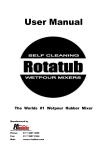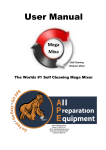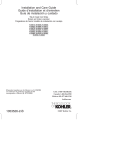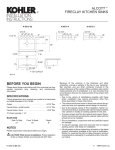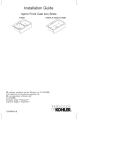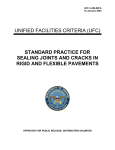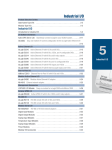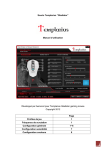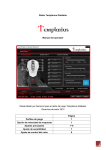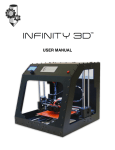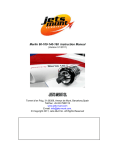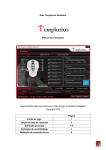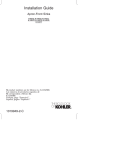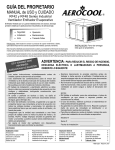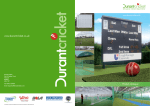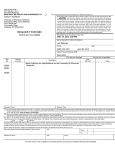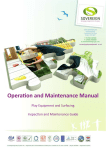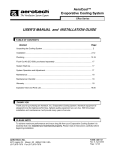Download INSTALLATION GUIDE
Transcript
INSTALLATION GUIDE Effective March 1, 2012 www.a1rubber.com Document No. OSMAR12INSTALL Disclaimer The installation instructions contained herein are given to the best of our knowledge. It is the installer’s obligation to check for any defects before any products are installed, claims will not be warranted for any visual defects after installation. A1 Rubber will not warrant any claim due to any actions whatsoever of the installer. In practice, the difference in materials, substrates and actual site conditions are such that no warranty in respect of merchantability or of fitness for a particular purpose, nor any liability arising out of any legal relationship whatsoever, can be inferred either from this information, or from any written recommendations, or from any other advice offered. Therefore professional construction advice should be sought in areas that are not covered in this installation guide. A1 Rubber reserves the right to change the properties of its products. Application, use and interpretation of these instructions are beyond our control and thus full installation responsibility falls exclusively with the installer. page 1 of 20 INSTALLATION GUIDE Effective March 1, 2012 Contents Introduction ...................................................................................................................................... 2 Careful Consideration ....................................................................................................................... 2 Step 1 - Ensure Products are Properly Stored .................................................................................. 3 Step 2 - Assemble Tools and Consumables Needed ........................................................................ 3 Step 3 - Survey the Site ................................................................................................................... 4 Step 4 - Water Collection System ..................................................................................................... 4 Step 5 - Prepare Substrate System .................................................................................................. 5 Step 6 - Test/Inspect Sub-Base ....................................................................................................... 6 Step 7 - Adjust/Prepare Asphalt/Concrete Substrates ...................................................................... 6 Step 8 - Confirm/Assess Site Size and Layout ................................................................................. 7 Step 9 - Base Aeroshockpad Installation ........................................................................................ 8 Step 10 - Lay all Shockpads in a Brick Pattern ................................................................................. 8 Step 11 - Install Cut Tiles at Edges of Installation or at Posts and Play Equipment ............................ 8 Step 12 - Complete Final Shockpad Installations ............................................................................. 9 Step 13 - Preparing the Site for the Top Layer Wetpour Rubber Surface Application ........................ 10 Step 14 - Preparing the Mixing Area ................................................................................................. 10 Step 15 - Preparing your Tools and Mixing ....................................................................................... 10 Step 16 - Trowel Runs ...................................................................................................................... 12 Step 17 - Screeding, Tamping and Finishing .................................................................................... 13 Step 18 - Continuing and Blending Trowel Runs .............................................................................. 13 Step 19 - Lap Joining ...................................................................................................................... 14 Step 20 - Finish Edges ..................................................................................................................... 14 Step 21 - Cleaning Rotatub and Tools .............................................................................................. 15 Step 22 - Barrier Tape and Notes ..................................................................................................... 16 Notes for Troubleshooting ................................................................................................................ 16 Appendix One - Australian Standards and Certification Information .................................................. 17 Appendix Two - A1 Rubber Critical Fall Height Graph ....................................................................... 19 Appendix Three - Finishing and Ramping Edges .............................................................................. 20 www.a1rubber.com QLD p (07) 3807 3666 f (07) 3807 2344 e [email protected] 34 Binary St, Yatala, 4207 NSW p (02) 9756 2146 f (02) 9756 2149 e [email protected] 40 Bentley St, Wetherill Park, 2164 VIC p 0408 607 888 f (07) 3807 2344 e [email protected] 16-24 Berends Dr, Dandenong S, 3157 page 2 of 20 INSTALLATION GUIDE Effective March 1, 2012 Introduction OneSafe is the easiest wetpour rubber system to install on the market today. The use of CSBR rubber crumb in OneSafe surfaces offers excellent colour consistency and therefore a great looking surface every time. Combining this with Aero Shockpad underlays makes installation super efficient with predictable performance every time. The OneSafe system is specified with the use of Procure as the rubber crumb binder. Procure has been specially formulated to provide excellent elastic properties which is a pre-requisite for any playground surface and the cure times are formulated for the widest range of atmospheric conditions to minimise the chances of shrinkage cracks. The OneSafe system has been extensively tested to exceed the requirements of the Australian Standards for critical fall heights and has been installed in both commercial and domestic applications, childcare centres, schools and council parks across Australia. This document provides step-by-step guidance for the installation of the OneSafe rubber wetpour system. Careful Consideration Raw material requirements per square metre vary depending upon the thickness required and the surface the product is being installed over. Prior to ordering and installation of the OneSafe Surface, careful consideration needs to be given to the following: 1. Make sure of your critical fall height requirements and choose the AeroShockpad and CSBR top surface thicknesses correctly. (See Appendix One for more details). 2. Double check the area size to ensure the correct amount of raw materials are ordered. (As a general guide 25kg of CSBR granules will cover approximately two square metres on a flat surface at 15mm thickness). The A1 Rubber sales staff can assist you further on detailed product usages if required. 3. The OneSafe system is available in a range of colours (see the CSBR colour range on A1 Rubber’s website). Choose the correct CSBR colour quantities to suit the pattern or plans you have to work to. A1 Rubber installation assistance does not end with this installation guide. We are available by phone on 07 3807 3666 from 7.00am to 5.00pm Monday to Friday. Thank you for choosing the OneSafe rubber wetpour system for your surfacing requirements. www.a1rubber.com QLD p (07) 3807 3666 f (07) 3807 2344 e [email protected] 34 Binary St, Yatala, 4207 NSW p (02) 9756 2146 f (02) 9756 2149 e [email protected] 40 Bentley St, Wetherill Park, 2164 VIC p 0408 607 888 f (07) 3807 2344 e [email protected] 16-24 Berends Dr, Dandenong S, 3157 page 3 of 20 INSTALLATION GUIDE Effective March 1, 2012 Step 1 Ensure Products are Properly Stored Required Tools a) RotaTub wetpour mixer – check that all safety features are operational b) Tarpaulin – use as a protective throw down sheet for use under the mixer and binder buckets Binder Storage Store all polyurethane adhesives in a dry storage area. Storage life is approximately 9 months. Keep binder away from heat sources, sparks or open flames. Procure is supplied by A1 Rubber in pails and it is not flammable but appropriate precautions should be taken. Avoid spillages by storing and using the product on tarps and away from high traffic areas c) Plastic tray wheelbarrow d) Elbow length chemical gloves. e) Trowels – Thick-sided wooden trowels or polyurethane foam trowels for tamping and stainless steel pointed trowels for finishing. CSBR Storage Store all CSBR granules out of direct sunlight by covering it with a reflective silver tarp. Keep all CSBR covered sufficiently to avoid the product getting wet by rain or sprinklers. Aero Shockpad Storage Store all Aero Shockpads out of direct sunlight and rain. f ) Screed Bar – Concretors screed cut down to approximately 1 metre long. g) Height Guides – use the appropriate thickness to ensure the required surface thickness is achieved h) Extension leads - for use on the mixer i ) Buckets with litre indicators – for measuring the binder j ) 600mm carpenter’s square and a 1 metre steel ruler – use as a guide for marking and cutting shockpads. (If applicable) k) Measuring Tape – metric measurement units as shockpads are made to metric measurement standards. l ) Soft chalk sticks – to mark shockpads for cutting. (if applicable) m) Single barrel sausage dispensing gun for 600ml adhesive sausages Step 2 Assemble Tools and Consumables Needed Optional Tools a) Knee Pads b) Circular Saw – For volume shockpad cutting around edges. (If applicable) www.a1rubber.com QLD p (07) 3807 3666 f (07) 3807 2344 e [email protected] 34 Binary St, Yatala, 4207 NSW p (02) 9756 2146 f (02) 9756 2149 e [email protected] 40 Bentley St, Wetherill Park, 2164 VIC p 0408 607 888 f (07) 3807 2344 e [email protected] 16-24 Berends Dr, Dandenong S, 3157 page 4 of 20 INSTALLATION GUIDE Effective March 1, 2012 the installation over time. In areas where little or no moisture is expected to come in contact with the OneSafe surface (interior non-pool areas), subsurface drainage is not required. Consumable Items a) Disposable gloves and rags b) Duct or masking tape – to protect adjacent surfaces during your wetpour application. Orientation Although the final orientation of the installed surface may not be a matter of choice, some consideration should be given to the following items: c) Polysolv – use as a trowel lubricant, to clean the mixer and to remove adhesive spots and spills d) Stanley knife blades or equivalent. Step 3 Survey the Site Sub-Surface Drainage For outdoor OneSafe installations it is important that the sub-surface drains properly due to the porous nature of OneSafe. 1.) Naturally Draining Sub-Surface If the installation site is elevated (higher than adjacent grades) with natural drainage, and does not currently collect water, then additional sub-surface storm water management systems will, more than likely, not be necessary. The surface water will pass through the OneSafe surface and then drain across the top of the subsurface. 2.) Non-Draining Sub-Surface If the installation area is lower than the adjacent grades and/or tends to collect water, then a subsurface water management system must be installed. If the sub-surface is solid (i.e. concrete or asphalt) and water collects (deeper than 3mm) on the surface areas where OneSafe is to be laid, these areas must be filled with patch materials such as a fast setting, one component, polymer modified, cement based, self-levelling pre-mix mortar. (See surface preparation section). If the solid sub-surface is surrounding a pool or any other high water/moisture producing source, it is important that the sub-surface be sloped a minimum of 2% toward the water collection drains. The site owner should be advised if the surrounding area has drainage problems as this could affect the sub-base structure or planarity (subsidence) of www.a1rubber.com QLD p (07) 3807 3666 f (07) 3807 2344 e [email protected] 34 Binary St, Yatala, 4207 a) Direct Sunlight OneSafe is made from recycled rubber. Rubber absorbs heat from infrared light (i.e. surface heat is generated from exposure to direct sunlight, not so much from exposure to atmospheric temperature). Therefore, if the surface area is exposed to direct sunlight, design considerations could include shade sails. OneSafe, in direct sunlight, typically will have an average surface temperature that is high. On a bright sunny day, with direct sun exposure the surface temperature could be as high as 60°C. On shaded areas that receive partial shading the surface will be close to the same temperature as the atmosphere. b) Continually Shaded or Damp Areas Installation sites in high humidity and/or shaded locations may remain continually damp. If warm temperatures are added to these damp areas the OneSafe surface may be subject to fungal or mould growth. In these conditions, mould has been known to use the rubber surface as an attachment in the search for food. The rubber can be penetrated by the mould searching for a food source, which leads to polymer degradation and carbon black exposure. In these scenarios the surface should be maintained regularly (see maintenance section) by washing with watered down vinegar and steam cleaning. Step 4. Water Collection System (If Necessary) The following is a guideline for preparing substrates that do not already have a properly prepared base. NSW p (02) 9756 2146 f (02) 9756 2149 e [email protected] 40 Bentley St, Wetherill Park, 2164 VIC p 0408 607 888 f (07) 3807 2344 e [email protected] 16-24 Berends Dr, Dandenong S, 3157 page 5 of 20 INSTALLATION GUIDE Effective March 1, 2012 Installed Water Collection System Carefully survey the site for drainage. Inspect the area after a rainstorm or test with local water supply. If this test results in the necessity of installing a drainage collection system, then complete the following steps: a) Excavate trenches to fit perforated agricultural pipe. Top of Agi pipe should be level with bottom of intended granular base. b) Install perforated Agi pipe with correct slope. Connect ends. c)Back fill trenches with 19mm clear, crushed stone. This 19mm stone should wrap the drainage pipe to a diameter of approximately 300mm. depends upon the sub-soil density. Typical requirements are from 50mm to 100mm thick. (75mm is average). Pack crusher dust with a vibrating packer or roller. d)Tie drainage system into existing storm sewer or ditch. Restore finished surfaces over trenched areas with appropriate ground cover (grass etc.). A properly designed and installed water collection system is often overlooked during OneSafe planning stages because in many cases a planner fails to give consideration to the porous nature of the finished surface. (Concrete and/or asphalt are by far the most common site surfacing options, where subsurface drainage may not need to be installed.) If the base is poor and subsidence is possible, excavate down further until a stable sub base or 300mm of depth is reached. Re-pack the subsurface with compacted road base in 100mm layers to 95% compaction. Screed and shape the final layer of the sub-base with crusher dust up to 100mm thick. d) Enhance crusher dust packing by applying water NOTE: Due to OneSafes porosity, it is critical that a proper sub-surface drainage system be planned and implemented or the OneSafe surface may not stay level and ultimately may become damaged due to sub-base subsidence. Step 5 Prepare Substrate (If Necessary) a) Mark out perimeter of the safety surface area with fluorescent paint. b) Excavate and remove soil/grass into the surface area. encroaching c) The minimum sub-base requirements for a OneSafe surface requires a compacted crusher dust surface. The depth of crusher dust required www.a1rubber.com QLD p (07) 3807 3666 f (07) 3807 2344 e [email protected] 34 Binary St, Yatala, 4207 e)Ensure upon completion the sub base surface is smooth and flowing. Ensure the depth from concrete paths etc. to the prepared substrate is the same as the thickness of the rubber system. NSW p (02) 9756 2146 f (02) 9756 2149 e [email protected] 40 Bentley St, Wetherill Park, 2164 VIC p 0408 607 888 f (07) 3807 2344 e [email protected] 16-24 Berends Dr, Dandenong S, 3157 page 6 of 20 INSTALLATION GUIDE Effective March 1, 2012 f) For applications of OneSafe where no fixed edge is able to be finished too, a ramp down edge into the surrounding grass or bark surface will be required. The edges of the sub-base preparation need to accommodate this requirement and therefore require the sub-base edges to be excavated to allow a gentle transition of the finished surface to enter and bury into the surrounds. See Appendix Three. Step 6 Test / Inspect Sub-Base During heavy rains water will remain on surfaces with slopes that are less than 2% due to the flow through of water through the OneSafe surface. In addition, water can collect on the sub-base if the planarity of the surface is not falling or smooth. If/when significant water volumes cannot escape from the sub-surface and water backs up under the product, sub-base subsidence may occur and could result in a damaged installation. To test slope and drainage, flood the area with water. Inspect the sub-surface. Be sure to inspect the sub-surface for proper planarity to ensure that the final OneSafe surface will be smooth & neat in appearance Sub-base preparation is sometimes completed under separate contract to the OneSafe installation. When the sub-base is completed by another contractor/installer, it is frequently not smooth enough for an immediate installation of OneSafe because: a) In cases where the sub-base is compacted crusher dust, the sub-base installation contractor may have left the site smooth and well packed, but it may have become disturbed prior to the arrival of the OneSafe installation crew. www.a1rubber.com QLD p (07) 3807 3666 f (07) 3807 2344 e [email protected] 34 Binary St, Yatala, 4207 c) The sub-base installation contractor may not have taken enough care to get the sub-base depth at the edges to match the depth of the rubber system. Solid sub-surfaces that vary in planarity are not a problem for OneSafe however; to rectify these situations, add crusher dust to the depressed areas. If more product is to be used to achieve a certain finished height, check with A1 Rubber that the compliance to Australian standards will not compromised. d) Remove any other obstructions preventing complete and unrestricted OneSafe installation. This includes the removal of debris from a surface that may have been just removed. Test the newly installed sub-base. Be sure to test the sub-base for proper slope in order to ensure that it will be properly draining. b) The sub-base installation contractor may not have taken enough care to get a sub-base surface to the specified planarity. Step 7 Adjust / Prepare Asphalt or Concrete Substrates (If Necessary) Inspect concrete finishes. Ensure there are no large cracks and/or loose materials that can be easily removed. Concrete should be broomed or blown clean prior to the OneSafe installation. For installations that do not require a shockpad underlay ensure that there are no oils or greases on the surface that may cause OneSafe to not adhere properly. Properly prepared asphalt or concrete surfaces are ideal sub-bases for OneSafe. Adhesion to a hard sub-base is not necessary but can have benefits. a) If/when OneSafe is laid on a concrete or asphalt sub-base, it is important to ensure that these sub-bases have cured/aged sufficiently. Curing time can vary by region, temperature and atmospheric moisture (relative humidity) but it is normally a minimum of 28 days for both asphalt and concrete. b) Ensure concrete/asphalt surfaces are dry if/ when the OneSafe is to be laid on this type of substrate. It is important to remember that NSW p (02) 9756 2146 f (02) 9756 2149 e [email protected] 40 Bentley St, Wetherill Park, 2164 VIC p 0408 607 888 f (07) 3807 2344 e [email protected] 16-24 Berends Dr, Dandenong S, 3157 page 7 of 20 INSTALLATION GUIDE Effective March 1, 2012 the single biggest reason for bonding failure is excess moisture at the time of installation. If the asphalt/concrete base is wet it must be allowed to completely dry before installation begins. A simple “layman’s” moisture test would be to leave a plastic sheet lying over the floor for 24 hours. If moisture is visible on the back of this sheet when it is lifted up and inspected, the floor is still curing or there is too much moisture from other sources. c) Mechanically sand/scarify loose particles paint, plasterboard compound and/or any other loosely bonded particles that need to be removed by sanding and/or scraping. d) Acid etch to enhance cleaning of concrete surfaces to increases the adhesion by opening the surface pores of the concrete. Mix 25% acid by volume to water (1part Acid to 3 parts water). Wash the entire area with this solution. A light broom scrub will be sufficient. This will also assist in removing any spills of diesel and/or oil spills/ stains, which is likely, spilled from the asphalt installation or concrete finishing equipment. After the complete area has been acid etched, carefully rinse the entire surface and allow adequate time for the concrete to dry completely. e) Power washing older concrete/asphalt substrates is recommended. The importance of a clean surface is often proportionate to the age of the concrete. If the concrete or asphalt base is new, it will likely be sufficiently clean to not require power washing. However, if recent construction was completed at or near the new concrete, a careful removal of all construction dust and other construction contaminants (plasterboard compound etc.) is essential. Preparation of Wooden Sub-Surface a) Wood Surface Types-Plywood or Planks. Either wooden surfaces can be solid plywood or deck planking (provided the spaces between planks do not exceed 6mm). Press-wood, chipboard, flakeboard and most particleboard are not acceptable wooden substrates. www.a1rubber.com QLD p (07) 3807 3666 f (07) 3807 2344 e [email protected] 34 Binary St, Yatala, 4207 b) Secure Loose Boards. Secure any loose Boards. Countersink protruding nail heads. Replace any damaged or rotting wood. Like all other sub surfaces, make sure the surface is clean and dry prior to the adhesive installation (see previous). Sand and scrape loose paint. c) Caution–Wooden Sub-Surfaces A wooden subsurface will experience more rapid deterioration after the rubber surface installation is completed. Since the wooden surfaces will collect moisture (due to the porosity of OneSafe), it is reasonable to expect that more rapid deterioration than normal of the wooden surfaces will occur. Wooden sub surfaces can also shrink in times of dry or drought conditions, this can lead to cracks in the OneSafe surface Concrete fibreboard and/or extruded, recycled plastic timber are ideal substitutes for traditional “wooden” sub-surfaces. Step 8 Confirm / Assess Site Size and Layout Confirm Adequate Materials to Complete the Installation It is important to have enough products to complete the entire installation in a single installation session for the following reasons: a) To Reduce Effect of Colour Change OneSafe like new wood, concrete, asphalt or any coated surface will change colour, over time, with exposure to UV. This change is not significantly noticeable when the whole installation changes colour equally. However, like installing a new piece of wood beside an older one, there will be a noticeable difference in the tone of the colour. OneSafe installed after several UV exposure days will be visibly different than any newer OneSafe. b) For Installation Conditions & Efficiency. Installing OneSafe at one setting ensures similarity in installation conditions and efficiency. NSW p (02) 9756 2146 f (02) 9756 2149 e [email protected] 40 Bentley St, Wetherill Park, 2164 VIC p 0408 607 888 f (07) 3807 2344 e [email protected] 16-24 Berends Dr, Dandenong S, 3157 page 8 of 20 INSTALLATION GUIDE Effective March 1, 2012 tiles should be run in the same parallel direction to the first row but this row of tiles should be offset started approximately halfway down the adjacent tile. This will give the tile installation a brick pattern. NOTE: The closer you can place the shockpads and OneSafe raw materials to the job site the faster and easier the installation will be. Step 9 Base Aero Shockpad Installation *IF SHOCKPADS ARE NOT REQUIRED, PROCEED TO STEP 14 Determine starting position. AeroShockpads are available in Slow Rebound Protection - SRP (30% polystyrene beads added) or solid rubber (100% 4 mesh rubber buffings). Both types offer consistency in density and thickness whilst the SRP version offers a lower percentage of rebound intensity (reduces risks of long bone fractures). Both products offer guaranteed on site performance for compliance to Australian Standards. Both the SRP and 100% rubber Aero Shockpads are suitable for installations over any substrate, including crusher dust, concrete and timber floors. Additionally Aero Shockpads offer very fast installation times in comparison to trowelled shockpad layers. To determine the most advantageous position of the first continuous row of Shockpads include all of the following considerations: a. Ensure that the cut edges around the entire perimeter of the installation will be equal in size. b. The first-continuous-row of tiles should be run through the area that requires the least cutting around posts and other structures. c. A popular starting position is to run down the length of any fixed straight edging that the job may finish against such as a patio edge etc. Step 10 Lay all Shockpads in a Brick Pattern Aero Shockpads should be installed in a runner bond (brick) pattern. The second run of continuos www.a1rubber.com QLD p (07) 3807 3666 f (07) 3807 2344 e [email protected] 34 Binary St, Yatala, 4207 Lay all full tiles up to the job perimeter or equipment poles and never continue a row of tiles past a pole without first installing the cut-in-tile. Continue running the Aero Shockpads down adjacent and offset to the last installed row of tiles until the entire area is covered. Step 11 Install Cut Tiles at the Edges of the Installation or at Posts and Play Equipment Marking Tiles for Cutting Install the shockpad in its desired position overlaying the perimeter of the installation. Where the Shockpad passes the perimeter, mark with a suitable marking chalk on both edges where it crosses. If the to-be-cut tile needs a straight cut, mark from one side of the tile to the other using a straight edge between your original markings. If the cut is to be curved, take additional measurements at 200mm intervals along the perimeter until a curve can be accurately marked. Cutting shockpads Straight lines or curved perimeter cutting. Use a fine tooth timber circular saw (handyman type) to rip NSW p (02) 9756 2146 f (02) 9756 2149 e [email protected] 40 Bentley St, Wetherill Park, 2164 VIC p 0408 607 888 f (07) 3807 2344 e [email protected] 16-24 Berends Dr, Dandenong S, 3157 page 9 of 20 INSTALLATION GUIDE Effective March 1, 2012 through shockpads. To set up for cutting, adjust the blade depth of the saw to 5mm less than then shockpad thickness. Simply rip the saw through the tile in a fast continuous motion (over cutting the mark where necessary for a Force Reduction Tight Fit - see important notes in step 13). The shockpad can be positioned and cut anywhere, i.e., on the grass, other shockpads or on a cutting table as long as the saw never protrudes the depth of the shockpad being cut. each Aero Shockpad tile is forced hard into each adjacent tile in both directions (without leaving crusher dust between the joins). This can be achieved by force reducing all tile rows by pushing from one end on the last tile to allow for the last tile to then be cut oversize to its actual requirements. Any contraction of the AeroShockpads in the cool night temperatures will be compensated by the memory expansion of each tile installed under a Force Reduction Tight Fit. Cutting around poles or objects. Once the tile is marked for cutting, experienced applicators simply tear away by hand the desired pole size and saw or tear to the tiles edge. Optionally a serrated jigsaw or Stanley knife can be used for more accurate cutting. Fill in’s. When only small slivers or chunks of shock pad material is needed (assuming a shockpad portion is not capable of being installed) simply crumb up by hand off cuts of shockpads and press firmly into and around the area to be filled. Alternatively, a mixed batch of 4 mesh buffings can be troweled in, which is also good for ramping down when necessary. Adhesive Seaming Adhesive Seaming of shockpad joins is only necessary where the Force Reduction Tight Fit method was not possible and/or as extra security to ensure gaps between each shockpad don’t occur during contraction when an unfinished job goes into a cool night temperature. To seam the shockpads with adhesive use Sikaflex 221 polyurethane adhesive and the appropriate dispensing gun. A bead of Sika approximately 8mm in diameter should be run down all tile joins. Step 12 Complete Final Shockpad Installation Compensate for expansion & contraction. Use the Force Reduction Tight Fit method to compensate for expansion and contraction of AeroShockpads. Shockpads, like any other rubber product, will expand and contract with temperature and atmospheric moisture changes. Tiles exposed to the sun (warmer) will be larger than tiles in the shade (cooler). Tiles laid in the morning at say 15°C will be smaller (cooler) than the same tiles laid in the afternoon at say 30°C. To minimise the effect of tile contraction in the evening after installation in warm conditions ensure www.a1rubber.com QLD p (07) 3807 3666 f (07) 3807 2344 e [email protected] 34 Binary St, Yatala, 4207 Generally if two applicators are available one should be the designated applicator of the adhesive and the other the designated spreader. Spread the adhesive by using a 100mm wide scraper tool to follow behind and spread and force the adhesive into the joins and its porous rubber sanctions. All joins and cuts, vertical and horizontal should be adhesive seamed when performing this application. NSW p (02) 9756 2146 f (02) 9756 2149 e [email protected] 40 Bentley St, Wetherill Park, 2164 VIC p 0408 607 888 f (07) 3807 2344 e [email protected] 16-24 Berends Dr, Dandenong S, 3157 page 10 of 20 INSTALLATION GUIDE Effective March 1, 2012 Dispensing tips should be cut at approximately 8mm diameter or greater. Approximately 18 to 20 lineal join metres can be seamed per adhesive sausage. Allow approximately 1 hour for curing in favourable conditions. Once the adhesive has cured satisfactorily the Aero shockpads are ready to have a top layer wetpour rubber surface applied. applicator. Once it is determined and agreed that a design is achievable mark out where colour changes will occur using soft chalk. Step 14 Preparing the Mixing Area Use tarps under your mixer. When choosing your Rotatub mixing area make sure the mixer is able to be placed on flat stable ground and power is accessible. The closer the mixer is to the job the easier the installation will be. Place throw-down tarps under your mixing area, between the mixer and the job and anywhere where your wheelbarrow will traverse and contamination of the customer’s surface could be a problem. The wheelbarrow will carry the mixed rubber to the applicators on the job site and therefore the wheel usually gets binder on it. Use throw tarps to avoid any damage to the customers surrounds. Check that your mixer is clean and all safety devices are in place. Test the mixer before placing your ingredients in the bowl to ensure the mixer is in good working order. Step 13 Preparing the Site for the Top Layer Wetpour Rubber Surface Application Blow site clean. Using a blower, blow any loose contaminates from the surface including loose rubber, leaves and similar debris. Ensure no matter what the top wetpour layer is to be trowelled over it is clean and free of solid protrusions that may penetrate through the intended depth of the wetpour layer. Step 15 Preparing your Tools and Mixing Measure and mark out the design OneSafe surfaces usually require colour changes throughout the surface to stimulate the play environment. Some OneSafe surfaces will require complex designs, patterns and colours to be installed. Unfortunately in most cases the applicator can only get close to the requirements of complex designs due to the limitations of working time and minimum batch/mix weight requirements. Careful consideration should be given to the actual ability of the applicator to deliver the design request within the capabilities of both the product and the www.a1rubber.com QLD p (07) 3807 3666 f (07) 3807 2344 e [email protected] 34 Binary St, Yatala, 4207 Lube your tools Usually one to two litres of Polysolv in an open top metal tin is sufficient to lay 100 square metres NSW p (02) 9756 2146 f (02) 9756 2149 e [email protected] 40 Bentley St, Wetherill Park, 2164 VIC p 0408 607 888 f (07) 3807 2344 e [email protected] 16-24 Berends Dr, Dandenong S, 3157 page 11 of 20 INSTALLATION GUIDE Effective March 1, 2012 of OneSafe top Layer wetpour. Refer MSDS for Polysolv safety precautions. A small rag is soaked in the Polysolv then used to apply a thin coating to the underside of the Screed Bar, the trowels and the Height Rods. Lubricant [Polysolv] is continuously applied as necessary throughout the installation to avoid binder build up and to lubricate the tools for free flowing trowel usage. Mixing Place the wheelbarrow sideways under mixer discharge shute before adding the CSBR rubber and the Procure binder. Plan your mix ratio of binder to rubber. The binder ratio is 20% of the CSBR rubber weight. An allowance needs to be made here for the binder dreg weight that will remain in your plastic measuring bucket. Generally approximately 300grams is left in the bucket when the mixer operator holds the bucket inverted long enough. A weight can be taken prior to pouring and after pouring to determine this weight accurately; it is significantly variable in accordance with the pour allowance time. EXAMPLE: 25kg CSBR x 20% = 5kg of Procure + 300g dreg. Total 5.3kg of Procure binder. Mark on the measuring bucket a height the correct weight of Procure will reach. Always fill to that mark. Remember repeated accuracy with the binder is paramount to avoid potential product failure. Mixer capacity Rotatub 25 can mix one 25kg bag of rubber plus binder and Rotatub 50 can mix 50kg of rubber and binder. Adding ingredients to the mixer Place the CSBR rubber onto the locked down mesh lid of the mixer and using a knife slice open the bag and empty the entire contents of the 25kg bag into the mixer. Choose how many bags to add subject to your mixer capacity and/or how much material is needed. If a colour blend is required ensure the blend formula remains the same for every mix. NOTE: Minimum mix capacity irrespective of the Rotatub size is 10kg of rubber plus binder. Pour the correct amount of Procure binder either through the mesh lid or into the bowl with the lid open. It is more efficient to pour through the lid, but this adds an additional cleaning task later. Avoid pouring the binder onto the centre mixer shaft with binder pouring preference given to the outer wall of the bowl as the blades can mix it through more effectively. Press the start button on the mixer and mix the ingredients for three and a half minutes. Ensure at the end of the mix time the CSBR rubber is adequately mixed and appears fully wetted out by the binder. Increasing the mix time slightly is possible as long as it is repeated accurately to avoid varying Binder Film Build. NOTE: Binder Film Build is the thickness of binder encapsulating each particle of rubber. Common wetpour binders are aromatic and therefore turn yellowish with UV exposure. This yellowish film affects primarily white, grey and light blue shaded colours. It can also affect any colour type from mix to mix if the Binder Film Build varies. The longer the ingredients are mixed the thicker the Film Build becomes due an increase in binder viscosity from the curing reaction. A thicker than normal Film Build of binder will make the surface look darker than a normal. www.a1rubber.com QLD p (07) 3807 3666 f (07) 3807 2344 e [email protected] 34 Binary St, Yatala, 4207 NSW p (02) 9756 2146 f (02) 9756 2149 e [email protected] 40 Bentley St, Wetherill Park, 2164 VIC p 0408 607 888 f (07) 3807 2344 e [email protected] 16-24 Berends Dr, Dandenong S, 3157 page 12 of 20 INSTALLATION GUIDE Effective March 1, 2012 Avoid circumstances where the wetpour rubber laying applicator is not ready for the delivery of the next mix. In this case don’t continue mixing past your standard mix time. If the applicator can’t use the mix reasonably quickly the mix may have to be discarded to avoid a potential colour variation from Binder Film Build variance. job site in a continuous manner. They are the only method of continuous applicator access to smooth out and blend the wet rubber for a seamless surface. Choosing the best place and direction to start trowel runs is determined as the narrowest width of the job and at the furtherest point away from the wheelbarrow [mixture] entry for the job. Preference should be given where possible to running the trowel runs across the narrowest width of the site to ensure the applicators can get back to the wet edge of the pour within the shortest time possible. Before discharging the rubber from the mixer, inspect the mixture to ensure the product is consistent without dry lumps or dry pockets. Once it is determined that the mix is satisfactory, whilst the mixer is still running push down on the mixer discharge handle and swing open the trap door allowing the rubber to pour into the wheelbarrow. Spread the rubber into the wheelbarrow as necessary to make it fit as needed. Do not put anything including hands up into the discharge hole of the mixer to help discharge the mixture. The width of OneSafe trowel runs should be approximately 500mm with the length being determined by the amount of mixture made per batch. This ensures the applicator can successfully reach and lean over to blend in the join of each trowel run. NOTE: See Rotatub User Manual for mixer safety, operational instructions and functions. Step 16 Trowel Runs Choose the best starting point Trowel Runs are an application procedure for playground surface wetpour rubber incorporating narrow strips of the poured rubber run across the www.a1rubber.com QLD p (07) 3807 3666 f (07) 3807 2344 e [email protected] 34 Binary St, Yatala, 4207 NOTE: The longest time a wet OneSafe edge should be left before blending/joining the next trowel run in is 15 minutes. If this is not achieved it may be hard to blend in the next trowel run, leaving the workmanship in the join susceptible to separation from expansion and contraction over time. This is why it is recommended to run the trowel runs across the narrowest dimension of the job, to ensure the fastest possible return to the wet edge. NSW p (02) 9756 2146 f (02) 9756 2149 e [email protected] 40 Bentley St, Wetherill Park, 2164 VIC p 0408 607 888 f (07) 3807 2344 e [email protected] 16-24 Berends Dr, Dandenong S, 3157 page 13 of 20 INSTALLATION GUIDE Effective March 1, 2012 Step 17 Screeding, Tamping and Finishing Height Measurement Guides Height Measurement Guides can be any material as long as they are slightly flexible and the right height. Apply Polysolv to the Height Guides as needed with a small rag to avoid product build up. Thin timber stripping is suitable and they can be purchased through hardware outlets at varying thicknesses. For example, for a 15mm thick OneSafe top layer, use an 18mm Height Guide. Height Guide usage is critical to maintain the correct thickness top layer throughout the installation. Place the Height Guides 500mm apart, parallel to one another on the sub-base or shockpads in the direction of the desired trowel run. Pour the rubber mixture from the wheelbarrow in between the Height Guides where necessary so the mixture can be easily screed out in between the guides. With the screed firmly sitting on the Height Guides, use a sawing motion to cut and move the rubber mixture along in between the guides until an evenly spread and consistent loose pour is achieved. Once the correct pour height and consistency is achieved remove the guides for Impact Tamping. Impact Tamping Impact tamping is performed to compact all the loose particles of rubber mixture into a tight fit. Impact Tamping requires the applicator to tamp the surface with a lubricated [Polysolv] thick bodied trowel whilst keeping the trowel flat at impact. Enough force needs to be applied to connect the particles of rubber closely together without compromising the planarity of the surface. This is best achieved via applicator feel and the end result required. After tamping 15mm surface thickness should be achieved if an 18mm Height Guide was used. This can be checked by doing a depth check through the wet mixture with a short length of 6mm diameter dowel marked accordingly. The tamping method is also used for moving the granules slightly sideways if necessary. www.a1rubber.com QLD p (07) 3807 3666 f (07) 3807 2344 e [email protected] 34 Binary St, Yatala, 4207 If an area of the pour needs to be thinned out, hitting down on the surface with a sideways impact causes the granules to move in the direction you require. Add amounts of mixture as necessary to any areas of the pour that need filling. This includes any small porous looking spots that need a only a very small amount. Finishing For a top surface free of lines and loose particles, use a ‘pointing’ steel trowel with the rear ends bent up (to prevent trowel gouging). Lightly lubricate the trowel with a rag soaked in Polysolv and wipe off any drips. Be sure not to flood the trowel with lubricant to avoid washing the binder out of the mixture. Holding your trowel on a slight upward angel to the direction trowelling in, smooth out in a side to side motion any lines and loose particles that may have been left by the tamping procedure. If any porous spots are found at this time they can be filled by adding more mixture as necessary. It is important to keep your trowel lubricated sufficiently to avoid reseparation of the rubber particles. Step 18 Continuing and Blending Trowel Runs Blend trowel runs thoroughly There are two areas where wet blends are required for continuing on with trowel runs; the width blend (shortest side) and the length blend (longest side). Using a tool, drag along the wet edge of the trowel run lightly to loosen up the edge for blending (Height Guide strips work well for this). Continue on trowel runs following the normal Screed, Tamp, Finish method by placing the Height Guides alongside for width (shortest) continuation running and one guide approximately 500mm out for length (longest) continuation trowel running. Pour the next mixture out evenly and screed it to height using the Height Guides, then follow the previous tamping and finishing steps. To blend the runs, using the tamping float, tamp down on either side and on top of the join with slight sideways impacts pushing the particles back and forth NSW p (02) 9756 2146 f (02) 9756 2149 e [email protected] 40 Bentley St, Wetherill Park, 2164 VIC p 0408 607 888 f (07) 3807 2344 e [email protected] 16-24 Berends Dr, Dandenong S, 3157 page 14 of 20 INSTALLATION GUIDE Effective March 1, 2012 together to blend the join and fill any porous spots. This should create a top surface with minimal visible signs of joining. It is important that all joins are blended thoroughly whilst still wet to obtain uniform surface strength. If trowel runs are blended late, the mixture may be difficult to blend and the trowel joins may be susceptible to cracking in due course with daily thermal expansion and contraction. Continuous application of the mixture in manageable size trowel runs and blending as you go will result in a seamless appearance over the entire area required. Place the edge of a lubricated trowel approximately 20mm to 30mm in from the edge of the pour, then firmly press down to half depth of the pour and pull/ drag the trowel away from the edge, spreading the pour out until it is ramped off to completely flat. 50 - 100mm 50% Step 19 Lap Joining Wetpour Shockpads Use Lap Joins to change colours or for joining Lap joints increase the surface area contact between a previously cured edge and a new wet edge. Wet to wet lap joins are possible during colour changes to ensure positive contact between the two wetpours. Lap joints are to be used when the site to be poured is larger than the toweling capacity of the crew within the one period. Displaceable Media Continue this method along the entire edge including cornering where needed. Various hand/trowel methods can then employed to ensure a clean squared off top edge remains to trowel back up too. NOTE: When joining up to a wet lap joint particular care needs to be taken to not disturb or contaminate the adjacent surface. Step 20 Finishing Edges Lap joints look like a continuous moulded small step at the edge of the pour. The depth of the step is half of the expected finished height of the top layer pour with the base of the step flaring out at least 50mm but not more than 100mm. To mould in a lap joint the squared off, full depth edge of the pour needs to be slightly proud of the expected finish pattern. www.a1rubber.com QLD p (07) 3807 3666 f (07) 3807 2344 e [email protected] 34 Binary St, Yatala, 4207 Edge Types. Various edge options are available to suit every application. Rampdown edges include those finished into grass, bark or sand perimeters. Ramping the OneSafe surface down into the perimeter reduces the risk of the edge being exposed to vandalism and reduces any potential water flow excavating the edges of the prepared sub-base works. See Appendix Three for more info. Fixed Edges are those finished up to hard surrounds like concrete or timber, and Rolled Off Edges are used where the surface is to be finished off on a hard surface like concrete. Ramping into Grass If the installation requires that the edge works be finished into grass you will need to ramp 100mm NSW p (02) 9756 2146 f (02) 9756 2149 e [email protected] 40 Bentley St, Wetherill Park, 2164 VIC p 0408 607 888 f (07) 3807 2344 e [email protected] 16-24 Berends Dr, Dandenong S, 3157 page 15 of 20 INSTALLATION GUIDE Effective March 1, 2012 down below the grass surface level around the perimeter of the installation. If Aero Shockpads are being used, allow them to follow over the edge into the excavated perimeter. Finish the pour off by toweling down into the excavated perimeter as needed. Once the surface is fully cured the edges can be back filled and suitably re-turfed. weight [foot traffic] applied along the edge of the rubber will break away any adhesion that may have been present with the fixed edge. Therefore if adhesion is required a polyurethane mastic sealant can be applied between the cured rubber and the fixed edge. When troweling up to a fixed edge simply trowel the OneSafe surface up to the edge keeping the top surface level with the fixed edge to avoid creating a trip hazard. Use a guide line when troweling along walls to ensure a neat straight height will be achieved. Ramping into Sand or Bark For bark or sand filled perimeters these are approximately 300 depths and commonly fall within the play equipment fall zones. The OneSafe surface including the Aero Shockpad layer needs to ramp right down to the sub-base level to ensure compliance if the loose-fill material is either excavated or low requiring topping up. The Ramp angle of the sub-base should not exceed 45 degrees and the transition should smoothly roll off into the loose-fill. Fixed Edge Adhesion It is not recommended to apply binder to any fixed edge to get better adhesion as this may lead to cracking in your surface further out from the edge if the surface is trying to contract away from the edge prior to full cure. A highly elastic adhesive is recommended to adhere any edges once cured. Fixed Edge Consideration When finishing a pour up to a patio or similar type aesthetic edge, consideration should be given to the requirement of masking the top side of the fixed edge to avoid binder contamination. Edge Gaps, a Common Problem Commonly, surrounding surfaces like OneSafe are required to slope away from patios, building walls and similar hard surfacing for drainage requirements. Unfortunately this can aid in the surface gently slipping away over time leaving an unsightly gapping between the surfaces. Similar problems occur with rubber surfaces that are surrounded by un-fixed concrete edging that can move away on the subbase leaving gapping. There are no guaranteed methods of rubber application to avoid these problems however, purpose designed extruded edge strips are available from A1 Rubber along with polyurethane gap fillers for use as and when necessary in this situations. Troweling up to fixed edges Generally there is insufficient binder contact with fixed edge surrounds to guarantee adhesion due to the particulate nature of the mixture. Additionally the OneSafe surface is compressible so a heavy www.a1rubber.com QLD p (07) 3807 3666 f (07) 3807 2344 e [email protected] 34 Binary St, Yatala, 4207 Hard Substrate Edges Determining the ramp down length onto hard substrates is subject to the thickness of the OneSafe surface and the requirements of the site/customer. To finish any length ramp-down edge the finished edge line must be determined first. Once this is known the ramp can be finished at no greater angle than 20 degrees. If the OneSafe surface is only 15mm thick a minimal length ramp is required however, to finish off any OneSafe edge to a hard substrate it should not be troweled any thinner than 8mm to provide a strong leading edge. This is performed by holding a lubricated steel trowel vertical on the substrate whilst resting at the edge of the pour then rolling it over onto the mixture to roll off the edge of the pour. If high traffic is expected, once the surface is cured, a light brush on coat of binder can be applied to the edge of the rubber up to 50mm in/wide. Step 21 Cleaning Rotatub and Tools Cleaning up at the end of the job makes for an easy start up the next day Place the wheelbarrow under the Rotatub mixer, and NSW p (02) 9756 2146 f (02) 9756 2149 e [email protected] 40 Bentley St, Wetherill Park, 2164 VIC p 0408 607 888 f (07) 3807 2344 e [email protected] 16-24 Berends Dr, Dandenong S, 3157 page 16 of 20 INSTALLATION GUIDE Effective March 1, 2012 then using the left over Polysolv [lubricant], pour it around the inside of the mixing bowl, over the blades and shaft while the mixer is running. Once fully wetted out with Polysolv, open the discharge door allowing the Polysolv and leftover materials to flow into wheelbarrow. Loosen the nut/wing-bolt on top of the mixer shaft, lift shaft out of bowl and place it in your wheelbarrow. Slide off the mixer paddles and the discharge guard from the outlet and clean thoroughly. Using a rag wipe all remaining Polysolv and rubber out of bowl leaving it to clean and dry. Once the Rotatub is clean place the paddles and shaft back into bowl and re-assemble. Place tools in wheelbarrow and clean as well. Cleaning your Rotatub mixer and tools thoroughly ensures that they won’t build with polyurethane. Step 22 Barrier Tape surface to determine whether it feels fully cured will be necessary in this case. Notes for Troubleshooting NOTE: Laying wetpour in outdoor conditions is subject to various surface failure types if the conditions of the day are not considered. Recycled tyre rubber fights off U.V degradation by converting the radiation into heat via the carbon black used in tyre manufacture. This heat excites the rubber particles expanding their size causing thermal expansion. During installation the rubber surface being trowelled (and the shockpad layer) can expand or contract with exposure to temperature change or direct sunlight followed by shade. Rubber surfaces on a 30˚C low humidity day, in direct sunlight, can reach surface temperatures of 60˚C, whereas in 100% shade the surface is generally at ambient temperature. Therefore surface temperature drops of more than 50% do happen when the surface goes from direct sunlight to direct shade. Shade can be from sails, a fence or a building etc. This is a problem when the surface has just been trowelled, as a slight contraction fracture can occur because the binder has not reached a strong enough cure. Therefore shockpad and top surface layers can expand and contract significantly during installation and curing when exposed to varying surface temperatures. High humidity days offer stable lower surface temperatures as the UV radiation is lower. Place barrier tape around the finished OneSafe job-site until fully cured. Full curing before the surface should be used is approximately 24 hours in moderate temperates and humidity. In some cases, where there is a known risk of traffic across the surface prior to curing, it may be necessary to contract a security services company [or similar] to ensure the surface is fully cured before use. In cold conditions with low humidity the surface may need up to 48 hours for full cure. An inspection of the www.a1rubber.com QLD p (07) 3807 3666 f (07) 3807 2344 e [email protected] 34 Binary St, Yatala, 4207 It is important to understand and predict any thermal movement by considering the environment on the day planned to wet pour the top surface layer. Failure to predict and adjust for the thermal movement of both the shockpad layer (either trowelled or prefabricated) and the uncured wet pour top surface layer can result in Thermal Contraction Surface Cracks (TCSC). The later in the day a surface is trowelled, the less time it has to achieve a strong enough bond before the cool of the evening sets in. If trowelling is NSW p (02) 9756 2146 f (02) 9756 2149 e [email protected] 40 Bentley St, Wetherill Park, 2164 VIC p 0408 607 888 f (07) 3807 2344 e [email protected] 16-24 Berends Dr, Dandenong S, 3157 page 17 of 20 INSTALLATION GUIDE Effective March 1, 2012 completed by say 4.00pm, and the temperature is cool, say 15˚C, and the surface is in direct sunlight, the rubber can reach temperatures up to 30˚C when the humidity is below 50% (eg. winter). Going into evenings like this the temperature can drop to approximately 5˚C or less. In these conditions the binder cure time will extend out usually all night until the temperature and humidity increases the next day. In this case the entire surface will be exposed to contraction from the significant temperature drop – whilst in an uncured state because trowelling was finished so late in the day. This is a typical example of a surface that will suffer from TCSC. A TCSC generally causes a barely visible surface crack initially, which then over a reasonably quick time exposes itself as a larger crack after surface use, extreme cold temperatures or daily thermal expansion and contraction. If a surface fails by TCSC they usually appear in the following places: Taking all of the above into consideration the best time to install a top surface wetpour layer is generally when the temperature of the day or the surface temperature of the rubber is on the increase. An allowance of time for curing should be made before predicted temperature drops based on the surfaces direct exposure to sunlight, the humidity and the ambient temperature of the day. NOTE: Never wet a freshly laid wetpour surface to speed up the cure time before a temperature drop or to reduce traffic risk before curing. Top layer wetpour cannot be laid in the rain and should not be exposed to rain prior to green cure. If a freshly laid surface is subject to any rainfall, the the binder cure rate increases as it is moisture curing. The curing reaction causes carbon monoxide cells to form within the binder film (like foaming) between the particles of rubber. This makes the bond between the rubber particles foamy and weak. This surface www.a1rubber.com GD can also be caused by the use of damp or sweaty rubber crumb. Product that is left in the the rain or weather for long periods of time can hold moisture in the bags and cause condensation to form on the rubber particles. In this case, once mixed, the cure time of the mixture will generally be reduced to only a few minutes before the mixture becomes unworkable. It is advisable to discontinue the application at this stage as the blending of the trowel runs will become problematic. Appendix One Australian Standards & Certification Information - Colour change join lines or cut-in patterns - Trowel run batch line joins - Base layer thickness changes - Base layer joins - Where base layers end QLD p (07) 3807 3666 f (07) 3807 2344 e [email protected] 34 Binary St, Yatala, 4207 once used will fail by Granular Delamination (GD). GD is where the top layer particles delaminate from there bond and lay loosely all over the surface. Certification of Compliance Introduction The Australian Standard AS/NZS 4422:1996 specifies testing requirements to determine the Critical Fall Height (CFH) for playground safety surfaces. The CFH is determined by dropping an instrumented headform from various heights onto the surface and measuring the point where one of two safety criteria are exceeded; those criteria are the Head Injury Criterion exceeding 1000, and the maximum acceleration due to the impact exceeding 200g. Heights tested include those which produce measurements that satisfy the relevant criterion and those which exceed the relevant criterion. A1 Rubber’s Products A1 Rubber manufacture a range of surfacing products for playgrounds. For many years A1 Rubber has been at the forefront of global innovation in impact attenuation performance. Our commitment to research, product development and factory controlled manufacture in this area has resulted in guaranteed on-site surface compliance to Australian Standards. All of A1 Rubber’s playground surfacing products (in varying thickness and densities) have been subjected to thousands of impact tests to NSW p (02) 9756 2146 f (02) 9756 2149 e [email protected] 40 Bentley St, Wetherill Park, 2164 VIC p 0408 607 888 f (07) 3807 2344 e [email protected] 16-24 Berends Dr, Dandenong S, 3157 page 18 of 20 INSTALLATION GUIDE Effective March 1, 2012 determine the best product specifications for the Standards criteria. An easy-to-use ‘Critical Fall Height Graph’ has been mapped from our test data which represents the relationship between surface thickness and Certified Fall Heights. elevated heights. Applicable surface types The Critical Fall Height Graph applies to the following A1 Rubber full playground surface systems: Rubberise – CSBR over Aero Shockpad Underlays The ‘Critical Fall Height Graph’ values only apply to products supplied and installed as specified by A1 Rubber. An allowance has been made for slight variations in top layer trowelling, ageing, some temperature variation, some wear and moisture but not for degradation, damage, contamination, hardening of the substrate or significant wear of the product after installation and use on site. Standard Wetpour – Oxide coloured wetpour over Aero Shockpad Underlays EPDM – EPDM over Aero Shockpad Underlays AeroCool – AeroCool tiles and coatings over Aero Shockpad Underlays Plātile – Plātiles over Aero Shockpad Underlays Substrates Varying substrate types do affect testing results of impact attenuating surfacing systems. Subbases such as crusher dust displace with impact. Accordingly displacement substrate values are shown on the graph. It is recommended that an allowance for hardening of displaceable substrates [often caused by drought] be made by the specifier. Synthetic Grass – Synthetic grass over Aero Shockpad Underlays Note: A standard 19mm sand filled synthetic grass layer offers no benefit or detriment to the CFH value and therefore no thickness inclusion is apportionable to the overall system. Some high density short pile synthetic grasses have a slight benefit to the value by approximately 5mm. How to use the Graph (Appendix Two) The surface thickness’ are shown at the bottom of the graph. The CFH values are shown vertically on the side of the graph. The determination for a CFH relating to the play equipment is always specified by the manufacturer of the equipment or the playground architect. Conclusion The objective of the Australian Standard 4422:1996 is to minimise the severity of head injury resulting from a fall. The standard gives a method of test by which impact attenuation can be determined on surfacing products. From these Critical Fall Height tests results can be mapped (see graph) that represent the upper limits in effectiveness for reducing head injury from falls onto these products. To determine the surface thickness from the known CFH value simply follow the line across from the CFH value until it meets the mapped test result line and follow it vertically downwards to determine the thickness required. Determining the surface layers thickness’ All thickness values shown on the graph are for the combined thickness of the top surface layer and the shockpad layer. Our rubber playground systems require the top surface layer thickness target to be 15mm up to the total surface thickness of 65mm. Surfaces which are a total of 70mm or thicker require the top layer to be increased to 20mm. Following this guideline offers the best surface support and strength during an impact event from www.a1rubber.com QLD p (07) 3807 3666 f (07) 3807 2344 e [email protected] 34 Binary St, Yatala, 4207 The values shown in the graph (Appendix Two) have been determined from test results as required by the standard. Certification of conformance to the standard in the form of a ‘Certificate of Compliance’ can be provided by A1 Rubber after completion for each specific site. Please don’t hesitate to contact A1 Rubber if you require further information on this subject. NSW p (02) 9756 2146 f (02) 9756 2149 e [email protected] 40 Bentley St, Wetherill Park, 2164 VIC p 0408 607 888 f (07) 3807 2344 e [email protected] 16-24 Berends Dr, Dandenong S, 3157 page 19 of 20 INSTALLATION GUIDE Effective March 1, 2012 Appendix Two A1 Rubber Critical Fall Height Graph 3.5 3.4 3.3 3.2 3.1 3.0 2.9 2.8 2.7 2.6 2.5 2.4 2.3 Critical Fall Height (m) 2.2 2.1 2.0 1.9 1.8 1.7 1.6 1.5 1.4 1.3 1.2 1.1 1.0 0.9 0.8 0.7 0.6 0.5 0.4 0.3 0.2 0.1 0.0 0 10 20 30 40 50 60 70 80 90 100 Surface Thickness (mm) www.a1rubber.com QLD p (07) 3807 3666 f (07) 3807 2344 e [email protected] 34 Binary St, Yatala, 4207 NSW p (02) 9756 2146 f (02) 9756 2149 e [email protected] 40 Bentley St, Wetherill Park, 2164 110 120 130 140 150 Concrete and/or solid sub-bases VIC p 0408 607 888 f (07) 3807 2344 e [email protected] 16-24 Berends Dr, Dandenong S, 3157 page 20 of 20 INSTALLATION GUIDE Effective March 1, 2012 Appendix Three Finishing and Ramping Edges Ramping into Grass, Bark, or Sand Wetpour Grass or Bark. Depth Shockpad Displaceable Media(75mm) nsio Ex te Sub Base Soil Grass Bark Sand Extension 150mm 300mm 300mm n Depth 100mm 300mm 300mm Butting up to a Fixed Edge Wetpour Grass Shockpad Layer Displaceable Media(75mm) Sub Base Soil Example Solid Edge The above specifications are derived from periodic tests taken on actual product from the manufacturing process. The data shown above represents the average values and /or performance calculated from these tests. Some variances are possible due to the use of recycled raw materials and common manufacturing tolerances. All users of the product despite our application examples should test for suitability of purpose prior to application. All orders for this product are subject to our standard Terms and Conditions of Sale. www.a1rubber.com QLD p (07) 3807 3666 f (07) 3807 2344 e [email protected] 34 Binary St, Yatala, 4207 NSW p (02) 9756 2146 f (02) 9756 2149 e [email protected] 40 Bentley St, Wetherill Park, 2164 VIC p 0408 607 888 f (07) 3807 2344 e [email protected] 16-24 Berends Dr, Dandenong S, 3157





















